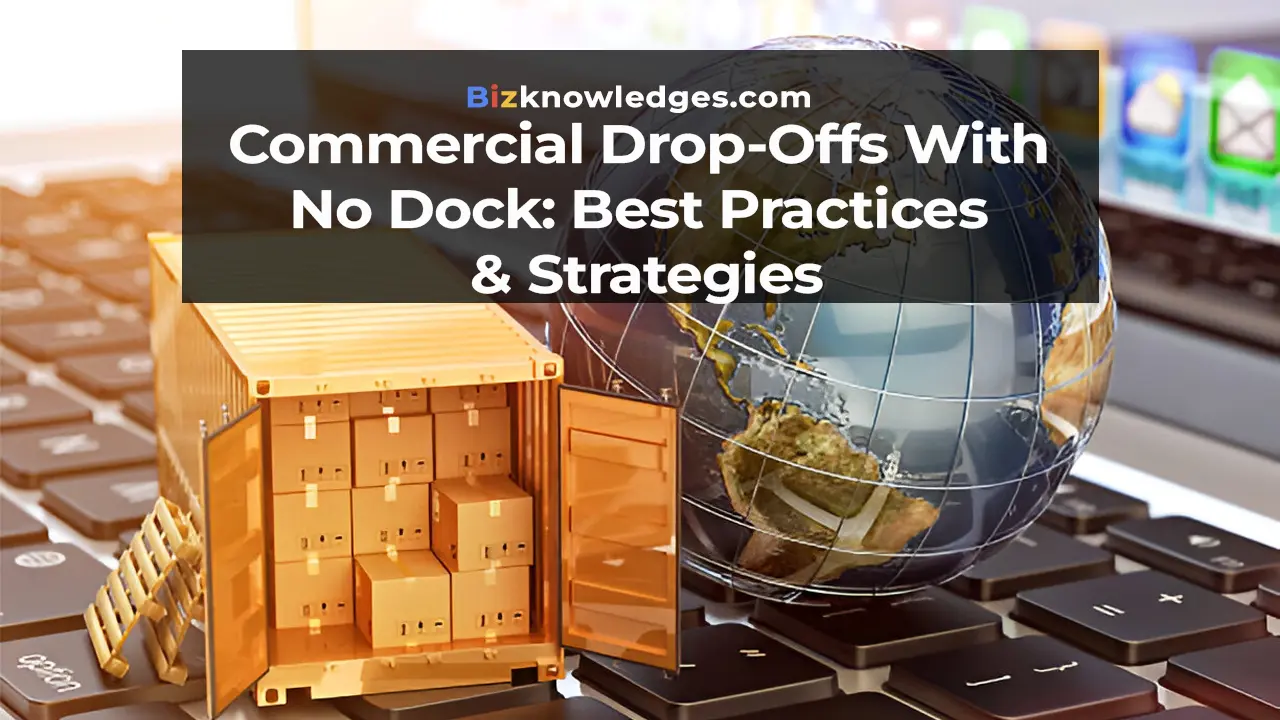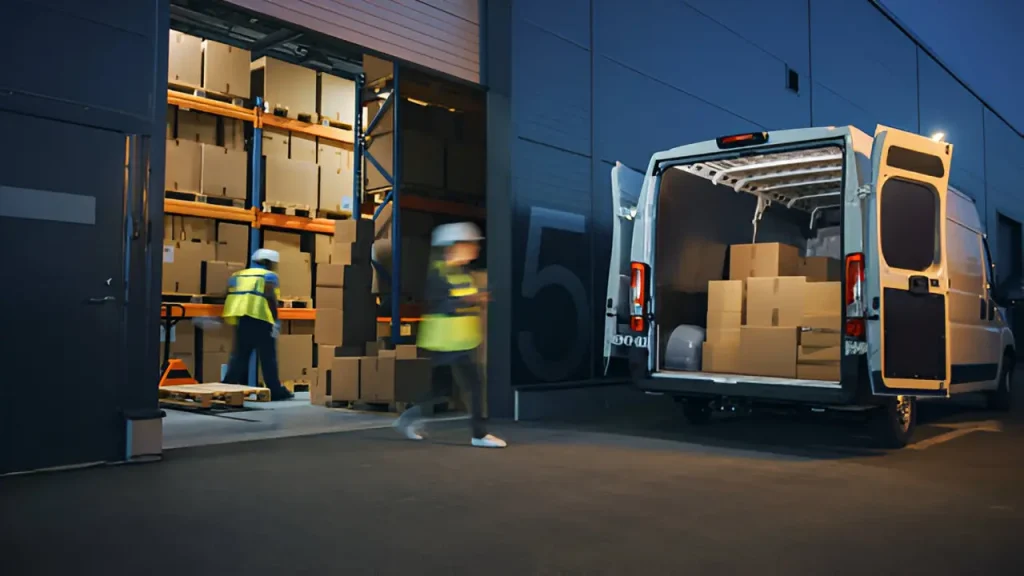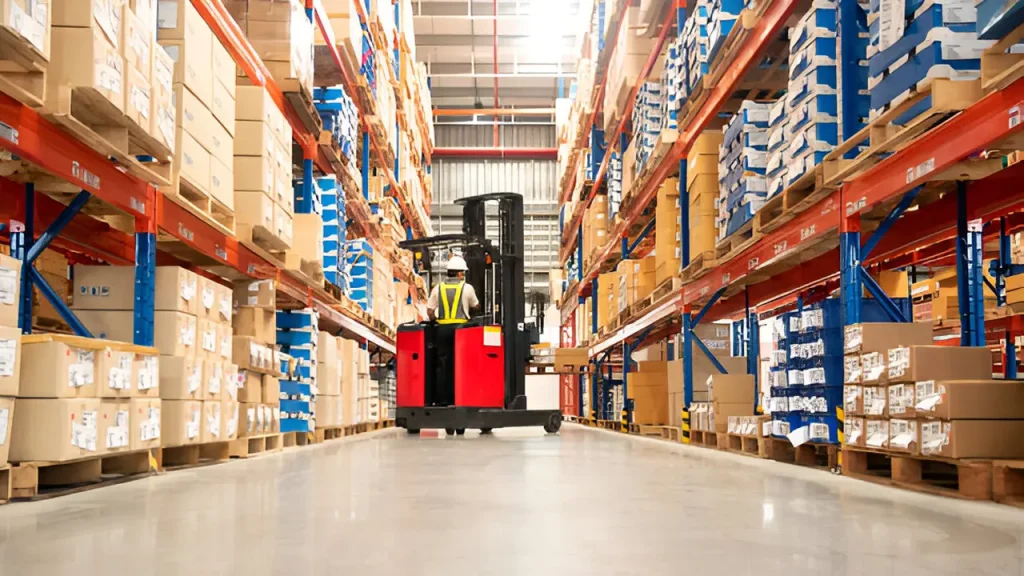Commercial Drop-Offs With No Dock: Best Practices & Strategies

The intricate world of commercial drop-offs—a realm where precision meets the pavement. As an expert navigating the ever-evolving landscape of logistics, I’ve mastered the art of seamless deliveries, even in the most challenging environments without traditional docks.
Every day, businesses face the daunting task of ensuring goods arrive safely and on time, regardless of the physical constraints they encounter. In this blog, I’ll share not just my insights but proven strategies that transform potential chaos into orchestrated efficiency. Join me as we delve into the essentials of managing commercial drop-offs, ensuring your business thrives in the face of adversity.
What is a Commercial Drop-Off with No Dock?
In the bustling world of delivery and logistics, a commercial drop-off with no dock represents a unique challenge and an increasingly common scenario, especially in urban environments or older buildings not originally designed for modern freight traffic. Typically, these are locations where goods need to be delivered directly to a business or commercial premises that lack a dedicated loading dock, making the process a bit more complex than a straightforward dock delivery.
Imagine navigating narrow city streets only to arrive at a destination that doesn’t have the usual commercial loading facilities. Drivers must then find alternative ways to unload their cargo safely and efficiently, often relying on manual handling or specialized equipment like lift gates or portable ramps. This kind of drop-off requires more than just physical logistics; it demands careful planning to ensure that deliveries are executed smoothly without disrupting the flow of traffic or business operations.
Businesses located in these no-dock facilities often face additional logistical challenges. They must consider how the absence of a dock affects everything from the speed of receiving goods to the labor required to handle shipments. Moreover, the situation necessitates robust coordination with delivery services to ensure that the arrival of goods is aligned with the availability of staff to manually receive and manage these shipments.
Challenges of Dockless Commercial Drop-offs
Dockless commercial drop-offs present a variety of logistical hurdles that can significantly impact the efficiency and effectiveness of delivery operations. These challenges aren’t just minor inconveniences; they are substantial obstacles that require innovative solutions and strategic planning to overcome.
1. Safety Concerns: Without a dock, the process of loading and unloading goods increases the risk of injuries for delivery personnel. Handling heavy items manually or using equipment like hand trucks on uneven surfaces or in confined spaces can lead to accidents. Additionally, the proximity to busy streets or public sidewalks during unloading can raise safety issues for both workers and pedestrians.
2. Time Delays: Deliveries at dockless sites often take longer. The absence of a raised platform means each item must be handled individually, usually from the truck to the ground and then to the storage area. This multi-step process slows down delivery times, impacting drivers’ schedules and potentially leading to delays in the supply chain.
3. Traffic and Congestion: Especially in urban areas, trucks parked for unloading without a dock can cause congestion. This can be a significant issue in narrow or busy streets where a parked delivery truck can obstruct traffic, leading to gridlock and increased frustration among local drivers.
4. Equipment and Accessibility Needs: To manage dockless drop-offs, businesses might need additional equipment such as portable ramps or lift gates, which represent an extra cost. Furthermore, the need for special arrangements, like coordinating with local authorities for parking permits or traffic management during delivery hours, adds another layer of complexity.
5. Weather Dependence: Dockless drop-offs are more exposed to the elements. Deliveries made during adverse weather conditions, such as rain or snow, can become more difficult and risk damaging the goods. This exposure requires additional protective measures and can complicate the unloading process.
6. Limited Space for Unloading: Many locations without docks are not designed to accommodate large trucks or the space needed for efficient unloading. This constraint can require smaller, more frequent deliveries, which might be less economical and more complex to manage.
Operational Strategies for No-Dock Drop-Offs
Overcoming the challenges of no-dock drop-offs requires well-thought-out operational strategies that enhance efficiency and safety while minimizing disruption and costs. Businesses and logistics operators can adopt several practices to better manage these complex scenarios.
1. Advanced Planning and Scheduling: Effective route planning and delivery scheduling are crucial. This involves analyzing traffic patterns, planning the best times for deliveries to avoid peak traffic hours, and ensuring that staff are on hand to quickly unload goods. Advanced scheduling tools and GPS tracking can help optimize routes and timing, reducing wait times and the risk of congestion.
2. Use of Technology: Implementing the right technology can significantly streamline the process. Mobile apps can facilitate communication between drivers and receivers, ensuring that both parties are prepared for the delivery. Technologies like electronic proof of delivery and real-time tracking systems enhance transparency and efficiency, allowing businesses to manage expectations and coordinate more effectively.
3. Staff Training and Equipment: Proper training for delivery personnel on how to handle deliveries in no-dock situations is essential. This includes safe manual handling techniques, effective use of portable unloading equipment like hand trucks, dollies, and portable ramps, and training on how to set up and use these tools safely.
4. Collaboration with Local Authorities: In areas where parking and traffic congestion are significant concerns, working with local authorities can be beneficial. Securing appropriate permits for loading and unloading, or even negotiating designated times or spaces for delivery operations, can mitigate traffic issues and legal complications.
5. Smaller, More Frequent Deliveries: Employing smaller delivery vehicles that can navigate tighter spaces more easily may be a viable strategy. Although this may increase the frequency of deliveries, it can reduce the time and complexity of each drop-off, making the overall process more manageable.
6. Weather Preparedness: Since deliveries without a dock are more vulnerable to weather conditions, planning for weather protection is important. This can include using weather-resistant packaging, having covers available for goods during unloading, and even scheduling deliveries based on weather forecasts whenever possible.
7. Building Strong Relationships with Receivers: Ensuring that there is good communication and relationship-building with the receiving businesses can facilitate smoother operations. When both parties understand each other’s needs and constraints, they can work together more effectively to handle the unique challenges of no-dock deliveries.
Equipment and Tools for Efficient Dockless Drop-offs
To navigate the challenges associated with dockless drop-offs, having the right equipment and tools is indispensable. These assets not only ensure the safety and efficiency of the delivery process but also help minimize physical strain on personnel and prevent damage to goods. Here’s a breakdown of essential equipment and tools that can significantly enhance the process of dockless deliveries:
1. Lift Gates: Trucks equipped with lift gates are a game-changer for dockless deliveries. A lift gate is a mechanical platform at the back of a delivery truck that can be raised and lowered hydraulically. This tool allows heavy items to be moved from the truck to the ground level safely and with minimal effort, reducing the need for manual lifting.
2. Hand Trucks and Dollies: These are fundamental for moving heavy or bulky items from the delivery truck to their final destination. Hand trucks and dollies are designed to navigate over curbs and through narrow spaces, which is often required in dockless drop-off scenarios.
3. Portable Ramps: Portable ramps can bridge the height difference between the truck and the ground, providing a smooth path for unloading goods using hand trucks or dollies. They are particularly useful where lift gates are not available, offering a practical solution for safely handling goods.
4. Pallet Jacks: For deliveries that are palletized, pallet jacks can make moving and positioning pallets much easier. They are especially useful in tight spaces where a forklift would be impractical.
5. Weather Protection Equipment: Given the exposure to elements during dockless drop-offs, having tarps and waterproof covers readily available is essential. These protect the goods from rain, snow, and even excessive sunlight, ensuring that they arrive in pristine condition.
6. Traffic Cones and Safety Signage: To enhance safety and manage traffic around the delivery area, using traffic cones and safety signage can help. These tools alert nearby pedestrians and vehicles to the presence of delivery operations, reducing the risk of accidents.
7. Communication Devices: Effective communication tools, such as smartphones or two-way radios, ensure that delivery personnel can coordinate with each other and with the receiving party. This is crucial for timing the unloading process efficiently and handling any issues that might arise during the delivery.
8. Wearable Body Cameras: These cameras can be used by delivery personnel to record deliveries. They offer a layer of security, provide proof of delivery, and can help resolve disputes or claims related to the delivery process.
The Importance of Planning for Non-Dock Deliveries
In the logistics and delivery industry, the absence of traditional dock facilities can complicate the seemingly straightforward process of unloading goods. Effective planning becomes critical to managing these non-dock deliveries successfully, ensuring that they are not only efficient but also safe and cost-effective. Here’s why meticulous planning is essential for handling non-dock deliveries:

1. Enhances Efficiency and Reduces Delays: Planning helps in mapping out the fastest and safest routes, considering potential traffic patterns and obstacles. This is crucial in urban areas where navigating narrow streets and finding parking can be challenging. By scheduling deliveries during off-peak hours, businesses can significantly reduce delays and enhance the overall speed of their operations.
2. Safety of Operations: The safety of both the delivery personnel and the public is paramount. Non-dock deliveries often require manual handling of goods, which can increase the risk of injuries. Planned operations ensure that all safety equipment and protocols are in place, such as using traffic cones and ensuring that heavy items are handled with appropriate machinery like lift gates or pallet jacks.
3. Cost Management: Without a dock, the unloading process can take longer, increasing labor costs and potentially delaying subsequent deliveries. Through effective planning, companies can optimize their delivery schedules and routes to minimize these extra costs. This includes determining the right type and amount of equipment needed for each drop-off point, which prevents wastage of resources.
4. Customer Satisfaction: Timely and efficient delivery is directly linked to customer satisfaction. By planning deliveries in advance, businesses can provide more accurate delivery times to their customers, improving the overall customer experience. This is especially important for businesses that rely on just-in-time delivery systems where delays can disrupt their operations.
5. Adaptability to Unexpected Challenges: Good planning includes contingency strategies for unexpected issues such as vehicle breakdowns, sudden traffic congestion, or adverse weather conditions. Having a well-thought-out plan allows businesses to adapt quickly to these challenges without significant disruptions to their service.
6. Regulatory Compliance: In many cities, there are specific regulations regarding loading and unloading in areas without docks, especially concerning traffic and pedestrian safety. Detailed planning helps ensure that all local laws and regulations are followed, avoiding potential fines and legal issues.
7. Reputation Management: Consistently managing non-dock deliveries effectively boosts a company’s reputation for reliability and efficiency. This can be a significant competitive advantage, attracting more business and fostering trust with existing customers.
Safety Protocols and Training for Non-Dock Deliveries
Safety is a paramount concern in the logistics and delivery sector, especially in scenarios involving non-dock deliveries where the usual conveniences of a loading dock are absent. Implementing robust safety protocols and providing comprehensive training are essential to ensuring that operations are not only efficient but also secure for everyone involved. Here’s a detailed look at the safety measures and training initiatives crucial for handling non-dock deliveries:

1. Comprehensive Training Programs: Training should cover proper manual handling techniques to prevent injuries, use of specialized equipment like hand trucks, dollies, and lift gates, and effective methods for securing loads. Additionally, it should include training on navigating deliveries in busy or compact urban environments where non-dock deliveries are common.
2. Use of Personal Protective Equipment (PPE): Ensuring that all delivery personnel are equipped with the necessary PPE, such as gloves, safety shoes, and helmets, is crucial. These items protect against common hazards associated with handling goods and equipment during deliveries.
3. Emergency Procedures: All personnel should be well-versed in emergency procedures. This includes knowing how to respond in case of an accident, how to handle hazardous material spills, and the steps to take if there is a vehicular breakdown or other emergencies during the delivery process.
4. Safe Loading and Unloading Practices: Specific protocols should be established for loading and unloading operations. This includes securing the vehicle during unloading, using traffic cones to alert passersby, and employing safety signage to inform nearby pedestrians and drivers of the ongoing operations.
5. Regular Safety Audits and Risk Assessments: Conducting regular safety audits and risk assessments can help identify potential hazards associated with non-dock deliveries. These assessments allow businesses to refine their safety protocols continually and address any new risks that arise.
6. Weather-Related Safety Measures: Delivery personnel should receive training on how to handle deliveries under various weather conditions. This includes using covers to protect the goods from rain or snow and understanding how to safely navigate slippery surfaces during unloading.
7. Ergonomic Considerations: Since non-dock deliveries often involve lifting and carrying heavy items, training on ergonomic practices is essential. This includes teaching techniques for lifting that reduce the strain on the body and using equipment designed to minimize physical effort.
8. Communication Protocols: Effective communication during deliveries can significantly enhance safety. This includes using radios or other communication devices to maintain constant contact between drivers, helpers, and the central dispatch unit to report any issues immediately.
9. Incident Reporting and Response: A clear protocol for incident reporting should be in place, ensuring that any accidents or near-misses are reported immediately. This allows for a timely response and helps in identifying trends that could indicate underlying safety issues.
Conclusion
In this comprehensive exploration of commercial drop-offs, we’ve navigated the complexities from what it means to manage deliveries without a dock, to the myriad challenges such setups pose. We delved into essential operational strategies that ensure efficiency and safety, discussed the crucial equipment and tools needed for smooth delivery processes, and underscored the critical importance of meticulous planning and robust safety protocols. Each component we’ve examined plays a pivotal role in optimizing non-dock deliveries, making them not just feasible but successful.
